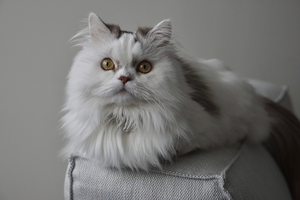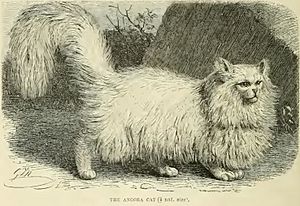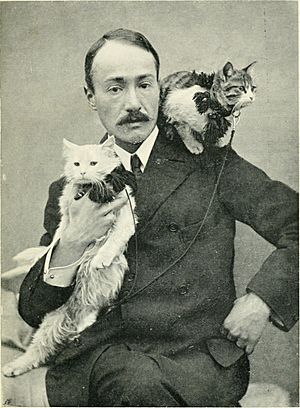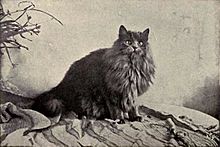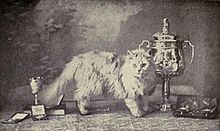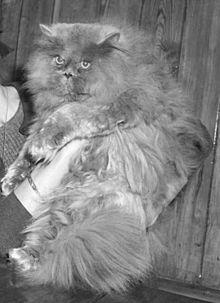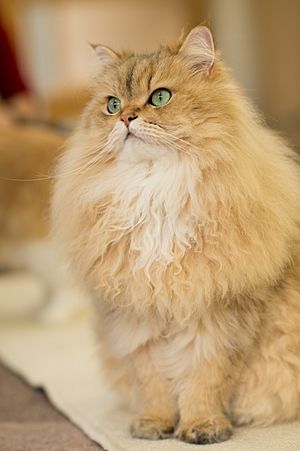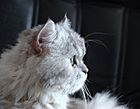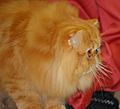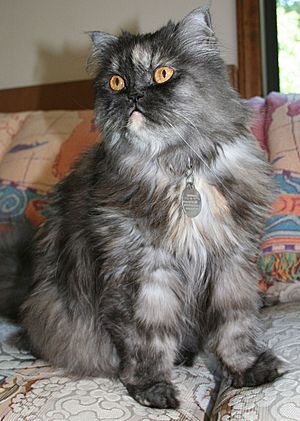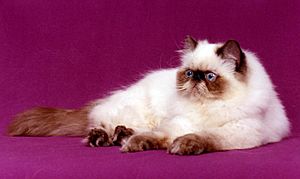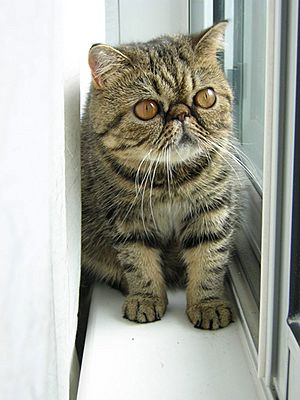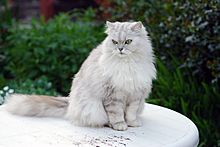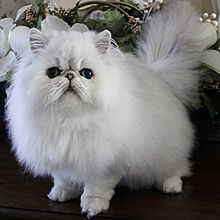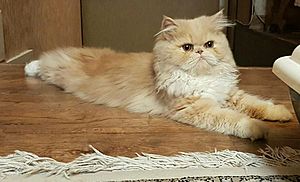Persian cat facts for kids
Quick facts for kids Persian cat |
|
|---|---|
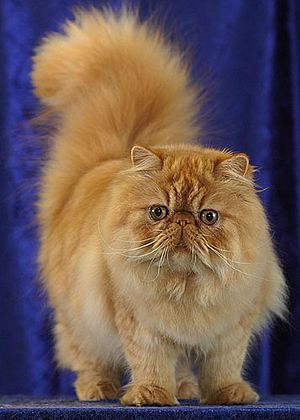
Modern-type Persian cat
|
|
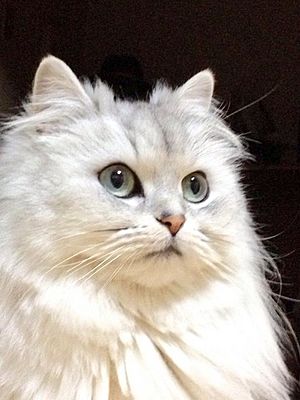
Traditional-type Persian
|
|
| Other names | Persian Longhair, Shirazi |
| Breed standards | |
| CFA | standard |
| FIFe | standard |
| TICA | standard |
| WCF | standard |
| ACF | standard |
| ACFA/CAA | standard |
| CCA-AFC | standard |
| GCCF | standard |
| Notes | |
|
The Exotic Shorthair and Himalayan cats are often classified as coat variants of this breed.
|
|
| Domestic cat (Felis catus) | |
The Persian cat, also known as the Persian longhair, is a popular breed of cat with long fur, a round face, and a short nose. These cats are known for their calm and gentle nature.
The first long-haired cats that might be ancestors of today's Persian cats were possibly brought to Italy from a region called Khorasan (in what is now Iran or Afghanistan) around 1620. However, there's stronger proof that long-haired cats were exported from Afghanistan and Iran starting in the 1800s. Cat lovers in Europe began to recognize them in the 19th century, and after World War II, breeders in North America, Australia, and New Zealand also started to appreciate them.
Over time, breeders have selectively bred Persian cats to have many different fur colors. This breeding has also led to some Persians having very flat faces. While some cat fans like this look, it can cause health problems for the cats. Some breeders are trying to keep the older style of Persian cat, called the Traditional Persian, which has a more normal-looking nose. A common health issue in the breed is a kidney disease called polycystic kidney disease (PKD), which used to affect nearly half of all Persians in some places.
In 2021, the Persian cat was the fourth most popular cat breed in the world, according to the Cat Fanciers' Association, a large cat registry in America.
Contents
History of Persian Cats
Where Did They Come From?
It's not totally clear when long-haired cats first appeared. The wild cats that are ancestors of our house cats didn't have long fur.
Some of the earliest records suggest that long-haired cats might have been brought to Italy from a region called Khorasan (in Iran or Afghanistan) in 1620 by a traveler named Pietro Della Valle. Around the same time, another traveler, Nicolas-Claude Fabri de Peiresc, might have brought similar cats to France from Syria.
In 1620, Della Valle described the cats from Khorasan as having beautiful gray fur, different from other long-haired cats he had seen. He wanted to bring them to Rome.
The name "Persian cat" was eventually used for long-haired cats brought from Afghanistan, Iran, and nearby areas, mainly for marketing in Europe. People in Persia (Iran) didn't actually call any specific cat breed "Persian cat."
In the 1800s, British travelers described long-haired cats being exported from places like Kabul (in Afghanistan) to Europe and India. These cats were often called "Persian cats," even though they weren't always from Persia itself.
Genetic Background
Recent genetic studies show that today's Persian cats are actually more closely related to cat breeds from Western Europe than to cats from the Near East. This means that even if the first long-haired cats came from Persia, the modern Persian breed has changed over time.
The modern Persian cat breed is genetically very similar to the British Shorthair, Chartreux, and American Shorthair. The Exotic Shorthair breed, for example, was created in the late 1950s by mixing Persian cats with American Shorthairs.
How the Breed Developed
Persians and Angoras
The first Persian cat was shown at the very first organized cat show in London, England, in 1871. As cats with the look we now know as Persian became more popular, people tried to tell them apart from Angora cats.
In 1889, a cat show organizer named Harrison Weir created the first "breed standard" for Persians. He said Persians had longer tails, fuller and coarser hair, and larger heads with less pointy ears than Angoras. However, not everyone agreed on these differences.
In 1909, Dorothy Bevill Champion explained the differences: Persian cats had rounder heads and a woolly undercoat with long outer hair. Angora cats had long, soft hair that hung in locks and was sometimes wavy. Angoras had more wedge-shaped heads. She noted that mixing the two breeds had improved both.
Traditional Persian Cats
The traditional Persian, also called the doll-face Persian or moon-face Persian, refers to the original look of the Persian cat. This look doesn't have the very flat face that some modern Persians have.
Over time, many breeders in different countries started to breed Persians to have flatter noses, sometimes called "peke-face" or "ultra-type." This happened because of natural genetic changes and selective breeding. Some cat organizations, like the Cat Fanciers' Association (CFA), now consider the peke-face type as their modern standard. So, the name "Traditional Persian" was created to describe the original look, which is still bred today. It's similar to how the original Siamese cat is now called the Traditional Siamese to tell it apart from the modern Siamese with a longer face.
Not all cat groups recognize the Traditional Persian as a separate type.
Modern Persian (Flat-Faced Types)
In the late 1950s, a natural genetic change in some red tabby Persian cats led to the "peke-faced" look, named after the flat-faced Pekingese dog. This type was briefly recognized as a separate breed, but it became less popular by the 1990s because of serious health problems.
However, breeders liked the flat-faced look and started breeding other Persians to have similar features. This extreme breeding, called extreme- or ultra-typing, made Persians look even more like the peke-faced cats.
In 1958, a breeder named P. M. Soderberg warned that too short a face could cause problems like watery eyes, which would stain the fur. He also said that a very short, upturned nose could look "grotesque."
Even as the look of the Persian changed, the official breed standard for Persians stayed mostly the same for a long time. The standard described a cat with a round head, large, wide-set round eyes, and a short, sturdy body. Everything about the ideal Persian was supposed to be "round."
It wasn't until the late 1980s that the standards were changed to try and limit the extreme flat-faced look. In 2004, a rule was added that noses should not be too pronounced. In 2007, the standards changed again to reflect the flat face, now saying that the forehead, nose, and chin should line up vertically.
In the UK, the standard was changed in the 1990s to prevent Persians with noses higher than their eyes from winning top prizes.
While ultra-typed cats often win in cat shows, the general public seems to prefer the less extreme, older "doll-face" types.
Types of Persian Cats
Himalayan Cats
In 1950, breeders crossed the Siamese cat with the Persian to create a new breed. This new cat had the body shape of a Persian but the unique "colorpoint" pattern of the Siamese (darker fur on the face, ears, paws, and tail). It was named the Himalayan, after other colorpoint animals like the Himalayan rabbit.
In the US, the Himalayan was a separate breed until 1984, when the CFA decided to group it with the Persian. This decision was not popular with some breeders who wanted to keep their Persian lines "pure."
The Siamese cat also introduced the chocolate and lilac fur colors into solid-colored Persians.
Exotic Shorthair Cats
In the late 1950s, some American Shorthair (ASH) breeders secretly used Persians to "improve" their breed. The mixed-breed look became popular in cat shows.
One ASH breeder saw the potential of this mix and managed to get the CFA to recognize it as a new breed in 1966, called the Exotic Shorthair. Because Persians are regularly used in breeding, today's Exotic Shorthairs are very similar to Persians in their personality and body shape, except for their short, thick fur. They have even inherited many of the same health problems as Persians. Some people call the Exotic Shorthair "the lazy man's Persian" because its coat is easier to care for.
Some Exotic Shorthairs can carry the gene for long hair. If two such cats mate, there's a chance their kittens will have long hair. These long-haired Exotics are not considered Persians by the CFA, but TICA does accept them as Persians.
Toy and Teacup Sizes
You might hear terms like "toy" or "teacup" Persians. These are generic names for very small Persian cats. They are not officially recognized as a separate breed by major cat registries. Each breeder sets their own size standards.
These terms can be controversial. Cats don't have the same genetic changes as dogs that allow for miniature versions. Some breeders use harmful inbreeding to get smaller cats, which can result in weaker cats with serious health issues and shorter lives.
Chinchilla Longhair Cats
The Chinchilla Persian started in England in 1882 by accident. A silver tabby and a smoke-colored Persian had a kitten named Silver Lambkin, who is considered the start of the Chinchilla Persian line. Even members of the British royal family owned his descendants.
In the US, there was an attempt to make the silver Persian a separate breed called the Sterling, but it wasn't accepted. Silver and golden Persians are recognized by the CFA. In South Africa, the attempt to separate the breed was more successful. The Southern Africa Cat Council (SACC) registers cats with five generations of purebred Chinchilla as a Chinchilla Longhair.
The Chinchilla Longhair has a slightly longer nose than the typical Persian, which helps with breathing and reduces eye tearing. Their hair is special: it's mostly clear, with black pigment only at the very tips. One unique feature of this breed is their blue-green or green eye color.
Official Recognition
How Cat Registries Classify Them
Different cat organizations have different rules for how they classify Persian cats and their related breeds.
- The Cat Fanciers' Association (CFA) sees the Himalayan as a color pattern of both the Persian and the Exotic Shorthair.
- The Fédération Internationale Féline (FIFe) simply includes the Himalayan colors as allowed patterns for both the Persian and Exotic, which they treat as separate breeds.
- The International Cat Association (TICA) treats both the Himalayan and Exotic as types of Persian.
- The World Cat Federation (WCF) considers the Persian and Exotic Shorthair as separate breeds and includes Himalayan colors under each.
Many regional and national organizations also have their own ways of classifying these cats, sometimes even recognizing "Exotic Longhair" or "Non-pointed Himalayan" as sub-breeds.
Popularity of Persians
In 2008, the Persian was the most popular purebred cat breed in the United States. However, in the UK, the number of registered Persians has dropped since the early 1990s. In 2001, the British Shorthair became more popular than the Persian. By 2012, the Persian was the 6th most popular breed in the UK. In France, the number of registered Persians also went down significantly between 2003 and 2007.
The most popular color patterns for Persians, according to CFA data, include seal point, blue point, flame point, and tortie point Himalayans. Other popular colors are black-white, shaded silvers, and calico.
Persian Cat Features
Appearance
A show-style Persian cat has very long and thick fur, short legs, a wide head with ears set far apart, large eyes, and a very short nose. While they originally had a short nose, this feature has become much more extreme over time, especially in North America. Persian cats can come in almost any color or pattern.
Fur Colors
Persian cats can have almost all possible cat fur colors and patterns.
The Cat Fanciers' Association (CFA) groups Persian cats into different fur pattern divisions:
- Solid colors (like white, black, blue, red, cream, chocolate, lilac)
- Silver and golden (including chinchilla and shaded types)
- Shaded and smoke (with many variations)
- Tabby (classic, mackerel, and spotted patterns)
- Parti-color (like tortoiseshell, blue-cream, chocolate tortie, and lilac-cream, mixed with other colors)
- Calico and bi-color (many variations of these mixed-color patterns)
- Himalayan (a white-to-fawn body with darker "points" on the head, tail, and legs, in various shades).
There are around 140 named CFA coat patterns for Persians and 20 for the Himalayan sub-breed.
The International Cat Association (TICA) also groups Persians by coat pattern for judging:
- Traditional (rich, stable colors)
- Sepia (paler and warmer, darkening with age)
- Mink (much lighter than sepia, developing color on face and paws with age)
- Himalayan (very pale body with intense color on points).
Within these groups, colors can be solid, tortoiseshell, tabby, silver or smoke, or mixed with white. TICA recognizes nearly 1,000 different coat pattern variations for Persians and Himalayans!
Persian cats can have many different eye colors, including blue, copper, green, blue-green, and hazel. Some can even have odd eyes (one blue and one copper). Specific eye colors are often required for certain coat patterns.
Behavior
Persian cats are generally known for being quiet and calm. They usually adapt well to living in apartments. Himalayans tend to be more active because they have some Siamese cat traits.
A study found that Persian cat owners felt their cats were more affectionate, friendly to strangers, clean, predictable, and vocal compared to mixed-breed cats.
Health of Persian Cats
Problems from Flat Faces
Modern Persian cats with very flat faces (called brachycephalic) have a large, round head and a very short nose. This face shape can cause several health problems:
- Breathing difficulties: Their short noses can make it hard for them to breathe easily.
- Skin and eye problems: Their tear ducts might not work properly, causing tears to overflow onto their face. This can stain their fur. Eyelids can also fold inward, causing eyelashes to rub against the eye, which is painful and can damage the eye.
- Eating problems: Their flat faces can make it hard to pick up and chew food. Some pet food companies even make special kibble shapes for Persians.
- Birthing difficulties: Giving birth can be harder for Persian mothers, leading to a higher rate of stillborn kittens.
A veterinary study in 2010 confirmed the serious health problems caused by the flat head shape.
Life Span
Data from Sweden shows that Persian cats (including Chinchilla, Himalayan, and Exotic types) live for about 12.5 years on average. Most cats live until they are about 15 years old. About 76% of these cats lived to 10 years or more, and 52% lived to 12.5 years or more. A study in England found an average lifespan of 12–17 years, with a median of 14.1 years.
Internal Health Issues
- Polycystic kidney disease (PKD): This disease causes cysts to grow in the kidneys, leading to kidney failure later in life (around 7 years old). It's a common problem in Persians. Luckily, there's a DNA test for PKD. Responsible breeders now test their cats to make sure they don't carry the gene, so their kittens won't get the disease.
- Hypertrophic cardiomyopathy (HCM): This is a common heart disease in all cats, and it's likely passed down in Persians. It causes the heart muscle to thicken, which can sometimes lead to sudden death. It usually affects male cats and those that are middle-aged or older.
- Eye problems: Some Persians can get a degenerative eye disease called progressive retinal atrophy, which can lead to blindness.
- Skin cancer: A type of skin cancer called basal-cell carcinoma can appear as a growth on the head, back, or chest. It's usually harmless, but sometimes it can be serious in Persians.
- Deafness: White cats, including white Persians, are more likely to be deaf, especially if they have blue eyes.
Bone and Joint Issues
Like some larger dog breeds, Persians can get hip dysplasia, a problem with the hip joint. However, because cats are smaller, they are usually not as affected by this condition as dogs.
Other Health Concerns
Persians can also be prone to other conditions, including:
- Skin issues like dry skin or infections in facial folds.
- Eye problems like excessive tearing or cataracts.
- Urinary problems, such as kidney stones.
- Heart problems.
- They can be sensitive to certain medications.
- They are sensitive to heat.
It's important to remember that even though these health issues can occur, many Persian cats live healthy lives without any of these problems.
Breeding Ethics
The breeding of Persian cats, especially for their very flat faces, has raised concerns about whether it's ethical to breed for features that cause health problems.
The flat-faced look, called brachycephaly, is popular because it gives cats big, owl-like eyes and a small face. However, these features lead to many health issues:
- Tears can build up and run down their faces because their tear ducts don't work well.
- Their soft palate (the roof of their mouth) can be too long, blocking their airway and making breathing difficult.
- They can have teeth and jaw problems, where their teeth grow in strange positions, making it hard to eat and leading to gum disease.
These health problems affect the quality of life for many Persian cats. This has led to questions about the ethics of breeding programs that create such extreme features.
After a TV program in the UK highlighted health problems in purebred dogs, cat breeders also faced pressure from vets and animal welfare groups. The Persian cat was specifically mentioned as a breed with many health issues. Animal welfare advocates have suggested changing breed standards to prevent diseases caused by extreme breeding.
For example, in the UK, the standard limits how high a Persian's nose can be. TICA and FIFe standards require nostrils to be open for easy breathing. Germany's Animal Welfare Act even forbids breeding flat-faced cats where the nose tip is higher than the lower eyelids.
Grooming Persian Cats
Persian cats have very long and thick fur that they can't keep clean by themselves. They need regular grooming to prevent their fur from getting tangled and matted. To keep their fur in the best condition, they should be brushed often. Another option is to shave their coat. Their eyes also need regular cleaning to prevent crust buildup and tear stains.
Persian Cats in Art
Artists and art lovers have shown their affection for Persian cats by featuring them in art for a long time. A very large painting, about 1.8 by 2.6 meters (6 by 8.5 feet), believed to be the "world's largest cat painting," sold for over US$820,000. This painting, called My Wife's Lovers, was from the late 19th century and showed a wealthy person's collection of Turkish Angoras and Persians.
Other famous paintings include White Persian Cat by artist Warren Kimble and Two White Persian Cats Looking into a Goldfish Bowl by Arthur Heyer. The beloved Persian cat has also appeared on stamps around the world.
See also
 In Spanish: Gato persa para niños
In Spanish: Gato persa para niños


